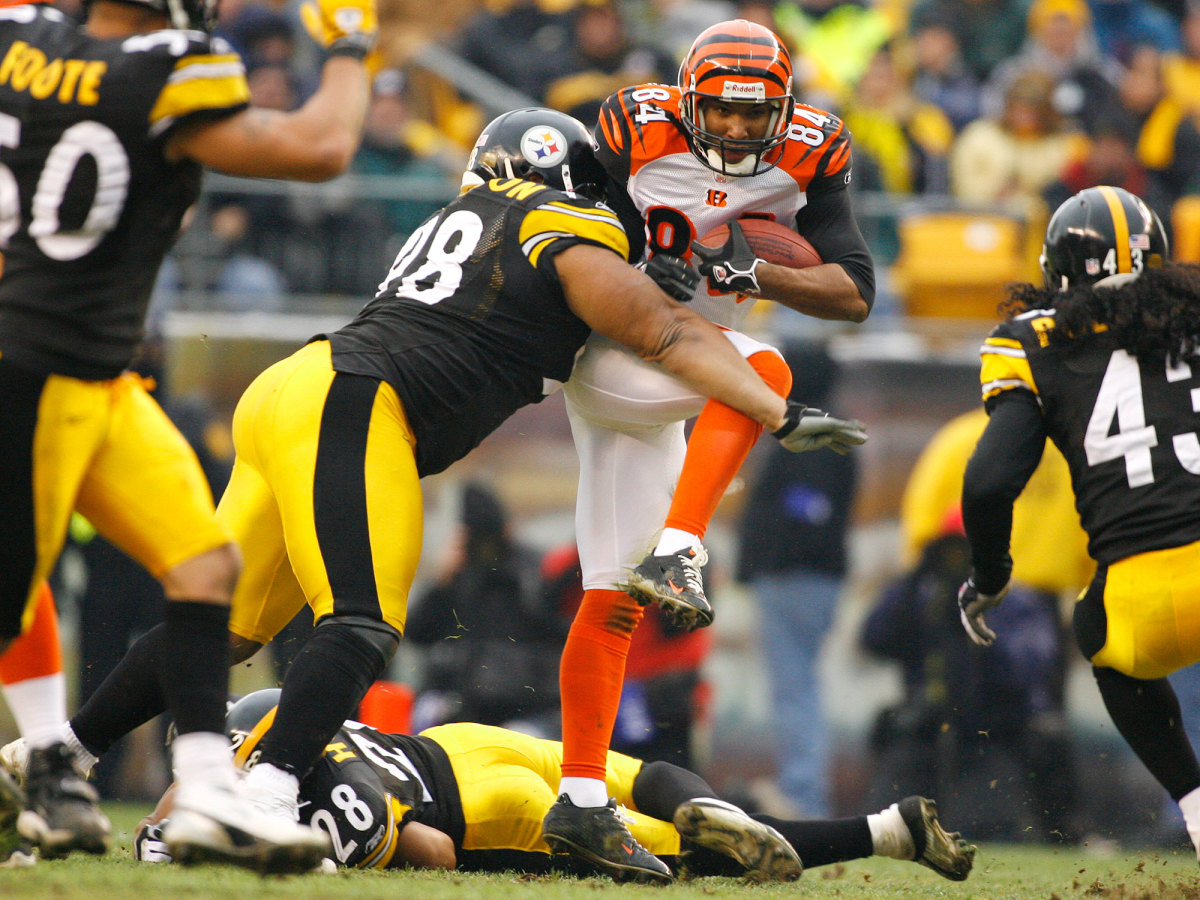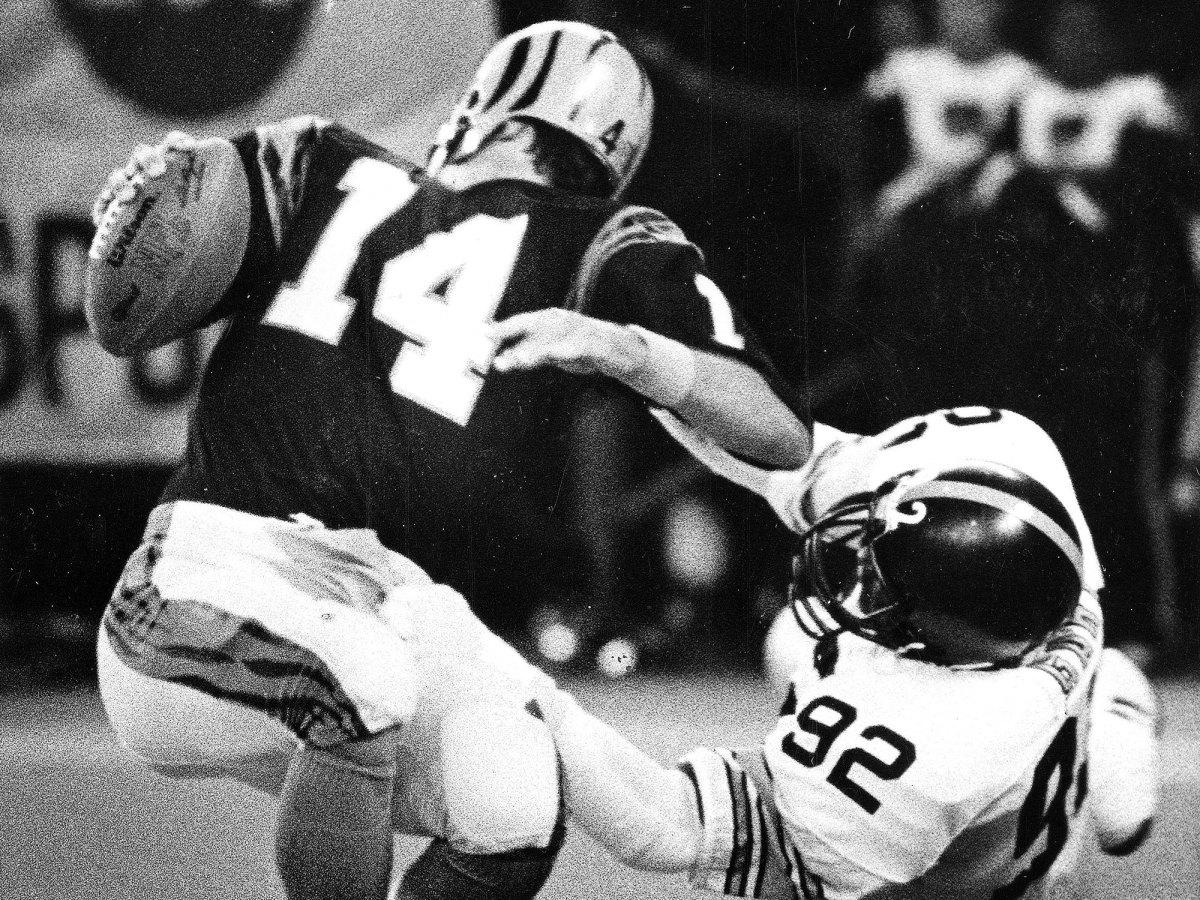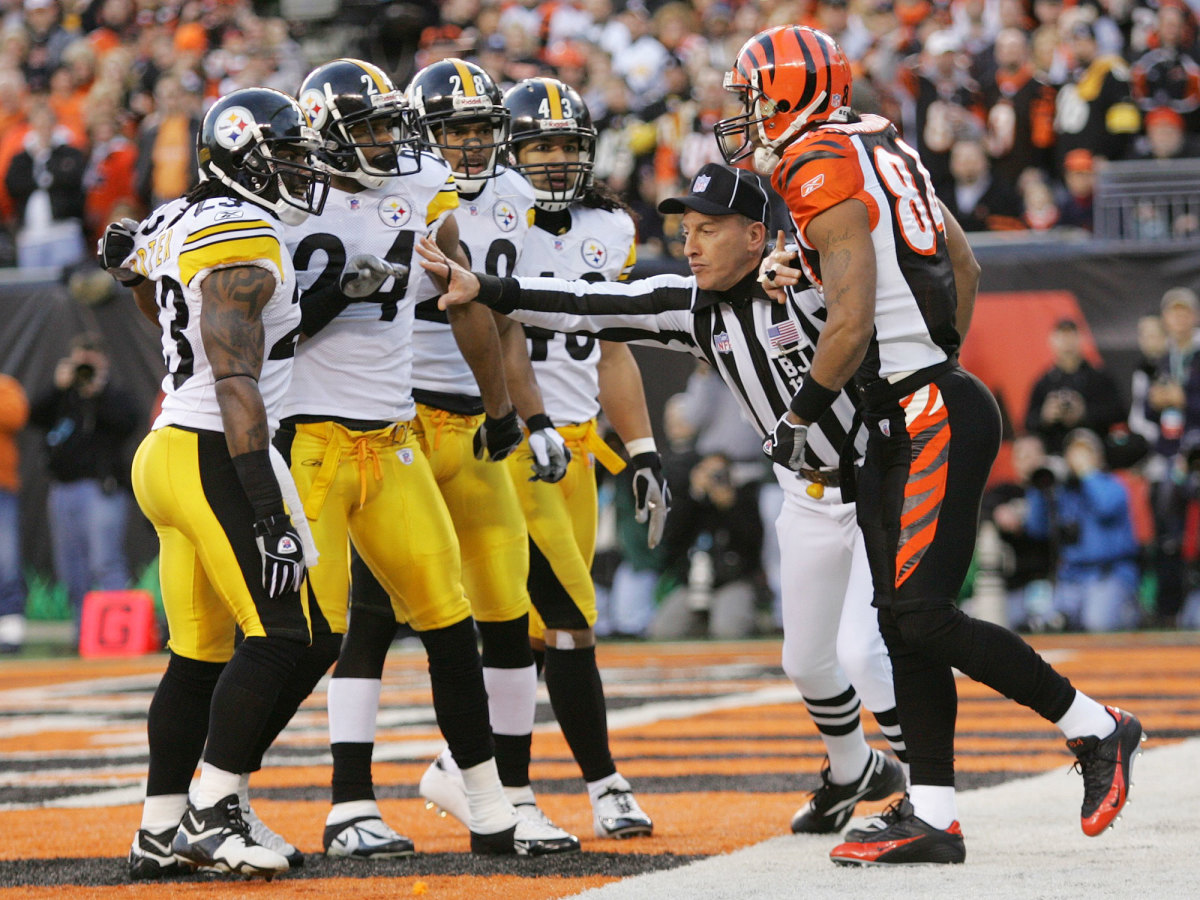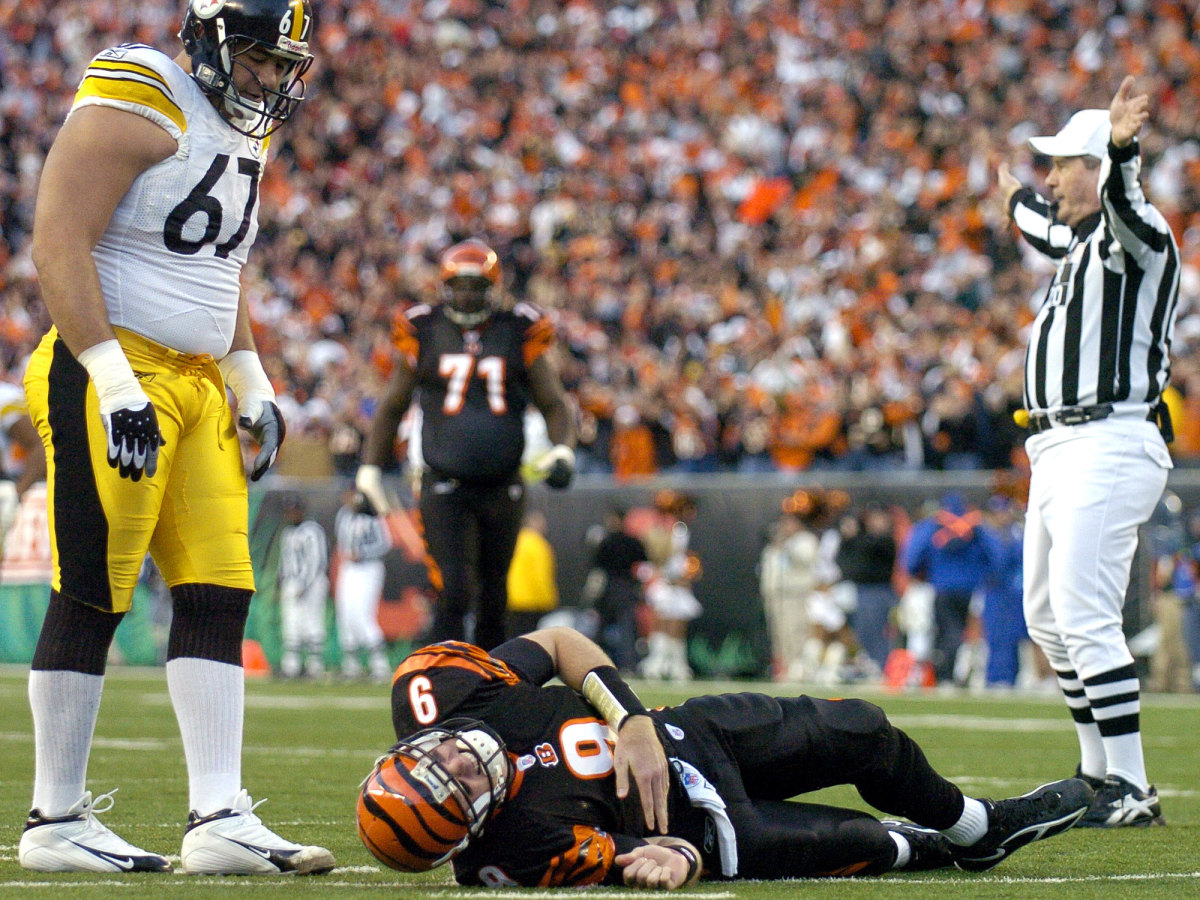Shift in the clash: Bengals ready to start new chapter in bitter rivalry with Steelers

It’s about 20 minutes after the Bengals secured their first victory of the season, a narrow 23–22 road win over the Jets, and the Cincinnati players populating the visitors' locker room at MetLife Stadium have no desire to talk about their next game.
That’s understandable, really. They know questions about their Week 2 showdown with the Steelers—which has recently transformed from a simple divisional rivalry into the fiercest, nastiest and most personal vendetta in the NFL—will be coming later. Right now, they just want to enjoy a win.
Mention the Steelers to running back Giovani Bernard, who was knocked unconscious by a helmet-to-helmet hit in their now-infamous wild-card playoff loss (emphasis on wild) last season, and he simply says “nope” and walks away. Ask cornerback Adam ‘Pacman’ Jones—who earned the dubious personal foul penalty in the waning seconds of that same game, gifting Pittsburgh the victory—and he stares back blankly, saying nothing. About half a dozen Bengals players follow suit, choosing not to comment on the Steelers or the idea floated that the rivalry may now be, finally, tilting in Cincinnati’s favor.
NFL Week 2 picks: Home teams under pressure to hold serve on Sunday
But over in the corner of the locker room, defensive tackle Domata Peko, one of the Bengals longest-tenured players, lurks. This offseason, at an NFL publicity event in London, when asked to finish the sentence the Pittsburgh Steelers are… Peko responded with “pieces of bleep.” Bring up that comment now and Peko backtracks slightly, saying he has nothing but respect for all opponents before admitting “it’s not just another game for us when we play [the Steelers].” He is judicious with his words, but when pressed Peko admits that in recent years match-ups between the Bengals and Steelers have less resembled football games, and have come closer to—his words—“fistfights.”
Two lockers to the right of Peko is fellow tackle Pat Sims. He’s still getting dressed, wearing only black compression shorts, but he’s been craning his neck to listen to Peko’s conversation, seemingly holding himself back from entering the fray.
But he can’t do so any longer. He feels compelled to chime in, unsolicited, with his take. Sure it is less diplomatic, but it is also off-the-cuff, and as a result almost certainly comes closer to resembling the true sentiments of the Bengals’ locker room.
“That’s how it’s supposed to be, man,” Sims says, in regards to the overwhelming physicality evident in the teams’ recent match-ups. “F*** them.”

It’s four days before the Steelers’ Week 2 contest, and former Bengals receiver T.J. Houshmandzadeh is more than happy to talk about the Steelers, his passion evident in the curse words that he uses as frequently as punctuation. He says that when he was watching the end of Cincinnati’s controversial playoff loss to Pittsburgh last year he found himself seething with anger, screaming at his TV. He felt as if he were playing in that game. His wife looked on incredulously, repeatedly reminding him that she thought he was crazy.
Is it crazy that he has already made sure that his daughter’s softball practice will end early on Sunday, so that he doesn’t miss the game? Maybe. But he doesn’t care.
“I’m not missing that game,” Houshmandzadeh says. “It’s Steelers week, baby. We owe these motherf******.”
Has it always been like this? This level of animosity, this frequency of invective slung 300 miles up and down the Ohio river?
This was a rivalry born out of familiarity and, yes, competitiveness. Sure, the Steelers, founded in 1933, are the oldest and most storied franchise in the AFC, while the Bengals didn't come into existence until ’68, beginning in the AFL before moving over to the NFL’s AFC Central division (with Pittsburgh) in ’70. And yes, it is fair to say that through the years the mighty Steelers have played the role of schoolyard bully, holding the ball high up over their head while the Bengals repeatedly leap up and down in a futile attempt to pry it out of their hands.
But in the early years the Bengals had some pretty good teams and players in their own right. Cincinnati won the division in their inaugural season in the NFL; the Steelers placed third and missed the playoffs. Franchise passing leader Ken Anderson looks back fondly on those early years of the rivalry, when things were, dare we say, amicable?
“It was a rivalry, sure,” Anderson says, “but there was a mutual respect there.”
Anderson says he had several friends playing in Pittsburgh. He remembers one game when Steelers tackle ‘Mean’ Joe Greene sacked him, then helped him up and said, “Hey Kenny, why don’t you stop in the locker room for a beer after the game?” And he did—having more than just one, actually, which caused him to miss the team bus to the airport.
Blanket Coverage: NFL grabbing the opportunity to remake Roger Goodell's image
But then came the Steelers string of dominance—the six straight division titles, the four Super Bowl wins—and the Bengals frustration, a word that has since become a bed rock of the franchise. Cincinnati had a winning record six times during that decade, yet never won a playoff game. “We happened to be stuck in a division with one of the greatest teams of all time,” Anderson laments.
Anderson led the Bengals to 12–4 record in 1981, the best mark in the league, winning MVP honors. He led Cincinnati all the way to the Super Bowl that year, before losing narrowly to Joe Montana’s 49ers, a campaign that still marks the franchise’s apex.
It wasn’t until 1983 that the rivalry would take a turn for the ugly. On a nationally televised Monday Night Football game in October, Steelers defensive end Keith Gary pulled Anderson to the ground with the most vicious face-mask penalty the league has ever seen. The quarterback’s head turned 180 degrees—resembling a scene from The Exorcist—before he crumbled, motionless, onto the grass.

For several minutes Anderson laid there, devoid of any feeling from his neck down. When the Bengals team doctor asked him if he could move his toes, Anderson didn’t want to try because he was afraid that he couldn’t. It took him several minutes for the tingling sensation to return to his extremities.
“It was gruesome when you saw the picture in the paper the next morning,” Anderson says. “The number on the back of my helmet is facing the same way as the number on the front of my jersey.”
The Bengals franchise latched onto that moment, the indelible image seared into their collective memories, fueling the ever-growing ‘bully-victim’ complex. Yet Anderson holds no grudge from the play. He says that he even received a handwritten note from Steelers owner Art Rooney afterwards checking to make sure that he was okay.
“Sure, we were pretty fired up the next time we went into Pittsburgh,” Anderson says. “But there was still a lot of respect in the rivalry at the time. [The animosity] may have begun then, but lately is when it has gotten over the top.”
The rivalry went on a brief competitive hiatus in the 1990’s and early 2000’s, as Cincinnati missed the playoffs in 14 consecutive seasons, from ’91 to ’04. Tight end Tony McGee, a Bengals second-round pick in ’93, remembers when games against the Steelers at home felt like they were being played in Pittsburgh.
“Back then, their fan base would buy all of the spare tickets,” McGee says. “It would be almost as loud for them in [Cincinnati] as it would be for them at home.”
NFL Week 2 Power Rankings: Surprise, surprise, the Pats are back on top
McGee knows that during his time in Cincinnati, "from an organizational stand point, we weren’t where we needed to be yet...[in terms of] having the consistency.” He readily admits that—while the Bengals had good players, and would often put up a good fight and steal a game here and there—in those days Cincinnati was chasing Pittsburgh like a dog chasing its tail. The Bengals lost eight straight to the Steelers from 1991 through ’94, which remains the longest one-sided streak in the rivalry’s history.
Bill Cowher, the Steelers coach from 1992–2006, says that the rivalry certainly still existed in those years, but that “I don't think there is any question” Pittsburgh was leading the way during that era. Cowher, now an NFL studio analyst on CBS, points out that Cincinnati went through a litany of coaches and quarterbacks over those years, never able to find the stability that the Steelers franchise possessed.
“There was always this constant search there,” Cowher says. “They would have their periodic good years, and they were always a good opponent. We never took them lightly. But they were never a team that consistently, year in and year out, won.”
Cowher points out that a true rivalry can’t be sustained when one team dominates the other. A true rivalry, Cowher says, is “built when you have a divisional opponent standing there looking you in the eye in December and you are fighting for a divisional crown. That is when it becomes personal.
“What changed,” Cowher continues, “is that they became a better football team.”
Fantasy football Start 'Em, Sit 'Em: How to set your lineups for Week 2
In December of 2005, the 8–3 Bengals—led by quarterback Carson Palmer and the wide receiver duo of Houshmandzadeh and Chad Johnson—traveled to Pittsburgh with a chance to clinch the division for the first time in 15 years. The rivalry was officially no longer dormant. For maybe the first time ever, the Bengals had a team built to wrest control of the AFC North away from the Steelers.
“That year we had the hardest offense in the NFL to stop,” Houshmandzadeh says. “The Steelers would always try to bully you, but we had a team then that could stand up to them. They had a lot of guys who talked s***. They talked s*** and they meant it in an I’m ready to f*** you up type of way. But when I talked s***, I meant it too.
“They would try to bully you on defense but we had guys on offense that wasn’t going to go for that. We had guys that weren’t punks. We had dogs. When you have those type of players that aren’t going to back down from the bully, and then you bully the bully, now you got a fight.”
Houshmandzadeh fondly remembers the intensity of those games—the trash talking, the vicious back-and-forth hits. He remembers breaking two bones in his back one season, the week before playing the Steelers, and still suiting up the following week because “you don’t want to miss those games.” He remembers the marked change in intensity in the week leading up to their matchups.
“Even the coaches acted different,” he says. “They are flaming the fire, and they don’t realize it, They want you to walk to the edge of that cliff but not jump.”
Houshmandzadeh remembers how personal the rivalry got in those days, how it even manifested off the field, like the time that Steelers linebacker Joey Porter punched Bengals tackle Levi Jones at a Las Vegas casino. (Porter pleaded no contest to a misdemeanor battery charge and paid a $1,000 fine). Houshmandzadeh remembers constantly chiding the Steelers defensive backs for playing Cover 3 zone, beseeching them to tell defensive coordinator Dick LeBeau to let them play man to man and then watch him “bust their ass.” He even remembers attempting to trash talk Troy Polamalu one game, after the safety hit him over the middle—“Is that all you got Troy? You hit like a b****”—and Polamalu getting up and saying simply, “God bless you T.J.”
“I felt so bad,” Houshmandzadeh says. “I never talked trash to him again.”

But what Houshmandzadeh remembers most is that game in December 2005, when the rivalry finally seemed to be tilting in the Bengals favor. Before the Cincinnati players departed for Heinz Field, the receiver found himself in the elevator of the Bengals team hotel with a coterie of Steelers fans, naturally talking trash. Houshmandzadeh asked one for his terrible towel, and the fan sarcastically responded that he'd give it to him for a hundred bucks. Then Houshmandzadeh pulled a $100 bill out of his wallet. He wore the towel dangling from the side of his pants during pre-game warmups.
“The Steelers were mad at me, but I didn’t give a f***,” Houshmandzadeh says.
Bengals coach Marvin Lewis implored Houshmandzadeh to take the towel off, and the receiver put up a fight before eventually handing it over to wide receivers coach Hue Jackson, who kept it in his pocket during the game. Houshmandzadeh went on to score two touchdowns in the game, and the Bengals won, 38–31, clinching their first playoff berth since 1990.
“That game set a tone,” Cowher says. “They came into Pittsburgh and they beat us. It let us know that going forward Cincinnati was not a team to be taken lightly.”
After the game ended, Houshmandzadeh immediately sought out Jackson and demanded his towel back. He began to swing it in the air, mimicking the Steelers faithful. And then, history was made.
"I don’t know what hit me, I don’t know what happened, I don’t know why I did it,” Houshmandzadeh says. “It was just instinct. I was like, just shine your shoe with it. So I just did it. I hadn’t planned it. It just happened. It was the magnitude of the game. I knew what was at stake.”
“From that time going forward,” Cowher says. “the rivalry took on a little bit of a different meaning. It became personal.”
“They look at [the terrible towel] like it’s the holy grail,” Houshmandzadeh says. “So when we played them in the playoffs, they were very mad.”
The Bengals finished that season 11–5, and then faced the Steelers again in the wild-card round—the first ever postseason meeting between the two franchises, the aftermath of which is still reverberating.
On Cincinnati’s second offensive play, defensive tackle Kimo Von Oelhoffen rolled up on Palmer’s leg seconds after the quarterback connected with the late Chris Henry on a 66-yard completion. Palmer’s knee was torn to pieces; his future, and the franchise’s future, irrevocably changed. The Steelers ended up winning the game, and then went on to win the Super Bowl.
“If Carson doesn’t get hurt, I believe that we win that game,” Houshmandzadeh says. “We’ll never know. But that was the beginning of [the rivalry] becoming what it is now.”

During the 2006 offseason, the NFL competition committee created a new rule prohibiting a defender from “forcibly hitting in the knee area or below a passer who has one or both feet on the ground.” It became known as the “Carson Palmer Rule.” And while it did nothing to change the outcome of the game, it did intensify the Bengals complex, their belief that they had been robbed.
Then came the “Hines Ward Rule” in 2009, which made blindside blocks illegal if the blocker’s helmet makes contact with the head or neck of an opponent, after the Steelers receiver broke Bengals linebacker Keith Rivers jaw. There was also the time in 2013 when Bengals punter Kevin Huber had his jaw and neck broken by Steelers linebacker Terence Garvin—no rules were changed, but the NFL admitted that they made a mistake by not issuing a penalty.
“Broken jaw, broken neck,” McGee says, “that’s when you can really start talking about a real rivalry. That’s what ratcheted it up to the next level.”
It all culminated in the wild-card game last season, the first playoff meeting between the two teams since that fateful contest in 2006. First Bernard was knocked unconscious by Steelers linebacker Ryan Shazier, another hit that went without penalty. Then with the Bengals leading 16–15 with 22 seconds remaining, Cincinnati linebacker Vontaze Burfict smashed into the head of Pittsburgh receiver Antonio Brown after an incomplete pass, earning a personal foul penalty (and, later, a three-game suspension.) In the ensuing ruckus, Porter (now a Steelers assistant coach) came onto the field and confronted Jones, who was then flagged himself for making contact with an official. The ensuing 30 penalty yards set the Steelers up for the game-winning field goal.
Porter was fined $10,000, and the NFL made a clarification to an existing rule that doesn’t allow coaches onto the field. Again, this did nothing to change the outcome of the game, and, again, it only furthered the Bengals belief that they were being marginalized and had been cheated.
“The Steelers didn’t win that game, the refs gave them that game,” Houshmandzadeh says. “If it were the other way around, [everyone would] have been saying that this can’t happen. But since it was the Bengals it was like, ‘Oh it’s just the Bengals, it’s not a big deal.’”
Amid the calls to better protect QBs, beware the unintended consequences
All throughout this week, in the buildup to their Week 2 matchup, players and coaches from both teams have downplayed the events of last year’s game, repeating a familiar refrain: It’s a new season. That’s true, of course. Actually, a lot feels new with this rivalry. Bengals tackle Andrew Whitworth, now in his 11th season with Cincinnati, notes that his team’s “mentality has changed” during his time in this rivalry.
“When I first got here, it was a huge feat [to beat the Steelers]. We felt like that game meant more than anything to us. We wanted to beat Pittsburgh just to say we did.” Whitworth says. “Now we realize we are just as talented as they are and we have as much chance [at a Super Bowl] as they do.
“We used to look up at them, like they are a really great franchise and we wanted to prove that we belonged,” he continues. “This is probably the first time in a while that they feel that there is a team year in and year out that is right there with them at the top of the division.”
Former Bengals players agree with this assessment. Anderson notes that, “the Bengals now have as good a roster as anybody in the league.” McGee points out that gone are the days when Steelers fans would outnumber Bengals fans in Cincinnati, “as they now have a national following and are starting to be recognized as a force to be reckoned with.” Even Cowher admits that “the teams are very evenly matched now,” crediting coach Marvin Lewis with restoring “pride, consistency and stability” to the franchise, which has made “it maybe the best rivalry in football today.”
Houshmandzadeh puts it in a way that only he can, saying, “This is their year to really do work. I think the Bengals have the better team this year, man. I really do. I can’t f****** wait to watch this game.”
Back in the visitor’s locker room at MetLife Stadium last week, Pat Sims is given the chance to elaborate on how he really feels about Pittsburgh. He’s asked what he thinks when he simply hears the word Steelers. He responds, “you don’t want to know my answer.” When he is assured that that isn’t true, he says, “I know you want to know, but it’s going to start some s***.
“You want me to tell you how I feel?” Sims then asks rhetorically, concluding his rant. “Come watch us on Sunday and you’ll see how I feel.”
